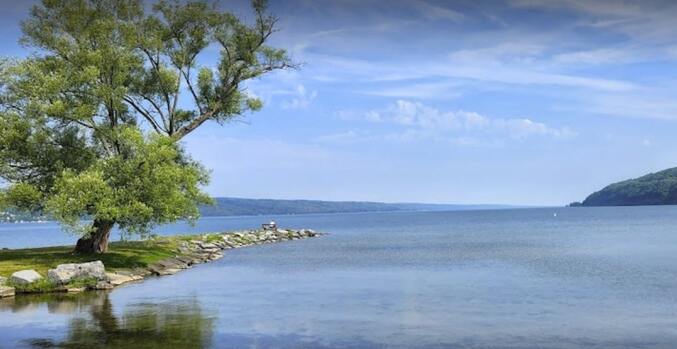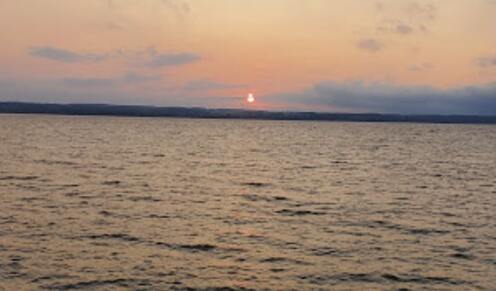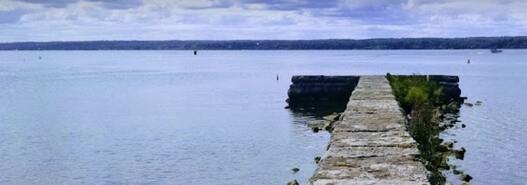
Among the most well-known of New York’s Finger Lakes, the picturesque Seneca Lake is home to a number of prominent tourist locations like the Seneca Lake Wine Trail and the Watkins Glen International racetrack. Seneca Lake is the largest of the Finger Lakes. It is also the longest, narrowest, and deepest. It is the second largest lake in length at 37.9 miles, and the deepest at that.
Seneca Lake’s magnificent waters attract sports enthusiasts from all over the world, who come to enjoy fishing, sailing, boating, and swimming. The hills around the lake are lined with vineyards covering hundreds of well-tended, scenic acres.
Seneca Lake is surrounded by picturesque communities, such as Geneva near the lake’s northern end and Watkins Glen.
Why is Seneca Lake Famous?
Seneca Lake is famous because of the following aspects:
- Moreover, half of the water in the Finger Lakes Region is contained in Seneca Lake.
- Seneca Lake is so long and deep that it typically freezes over once every hundred years. The last time the lake froze in 1912. People claimed to have skated 35 miles during the freeze, from Geneva in the north to Watkins Glen in the south.
- You can set out on a journey across the world from Seneca Lake. The lake is linked to the ocean via canals.
- Temperatures are kept in check by the lake’s size. Therefore, the surrounding terrain is suitable for producing grapes. The lake boasts 40 wineries, making it the most fertile of the Finger Lakes. More than 600,000 people visit these wineries each year.
- Seneca Lake plays host to the annual National Lake Trout Derby as the world’s lake trout capital.
- Tourists can walk on the lake floor even though it’s 200 feet below the water.
History of the Lake

In the 1800s, goods and people were transported on the Finger Lakes using steamboats and barges. A few of these barges have sunk to the southern end of Seneca Lake, where they were being maintained so that scuba divers could explore them. Sampson Training Station, now Sampson State Park, was utilized by the Navy and the Air Force during WWII to train soldiers on Seneca Lake.
The area around Seneca Lake was originally home to the Seneca Nation, the most westerly tribe of the Iroquois Confederacy. In 1779, however, all changed when George Washington gave orders for General John Sullivan to help the Revolutionary War cause by delivering complete destruction and devastation to hostile Iroquois communities. As a result of the campaign, many Seneca settlements were wiped out.
Thousands more fled the area, and those who stayed had trouble maintaining a decent level of living. Much of the property around Seneca Lake was conquered by the British during the Sullivan Expedition, and the men of the American Revolution were rewarded for their service with plots of land after the battle.
Even the nautical history of Seneca Lake is extensive. Sampson Naval Training Base, covering 2,600 acres, was built by the United States Navy in 1942. More than 400 thousand sailors received their pre-war training here. This location became a college for thousands of military veterans after the war ended.
The Air Force took over the site during the Korean War and utilized it to train over 300,000. The land is now the largest state park in the Finger Lakes area and features a museum devoted to the region’s military heritage. Visitors can explore the area in search of remnants of the military base, such as roads and foundations.
Geology of the Lake
Multiple glaciations, the most recent of which occurred 14,400 years ago during the Wisconsonian Glacial Epoch, effectively eroded this bedrock. Moraines left behind by these glaciers blocked the southern end of the Finger Lakes, redirecting their water flow north into Lake Ontario as they retreated to the north.
Meltwater from retreating glaciers created the Finger Lakes. When compared to the other Finger Lakes, Seneca Lake stands out for having the biggest surface area and the deepest pit. A series of proglacial lakes emerged as the glaciers retreated. The lakes sit at various altitudes, from 961 feet at Lake Newberry to 455 feet at Lake O’Hara.
Sediments thought to have been deposited by a prograde delta at a time when the surface of Seneca Lake was higher than it is now. Since the glaciers retreated, the bottom of Seneca Lake has undergone isostatic rebound.
Landscape
Surrounding Seneca, the land is fertile and damp, making it an ideal location for farming and a desirable prize for returning warriors. The steep landscape, which is covered in thick forests and striped with deep gorges, unfortunately cut off the farms from outside markets and slowed the development of commercial farming in the area.
The wine industry in the Finger Lakes thrived. Vineyards fared best on Seneca Lake, thanks to its relatively moderate temperatures and steady weather. Over fifty wineries now dot the landscape around the lake, each showcasing a unique blend of tradition and innovation in their grape varietals. Some wines from Seneca Lake have been recognized at the national level, and many others consistently receive high marks from wine experts. Tastings and tours at the several vineyards on Seneca Lake have grown into a lucrative multimillion-dollar industry. Between the vineyards, tourists can stop at any number of stores, cafes, restaurants, or resorts to sample the region’s handicrafts and cuisine.
Wildlife
Seneca Lake has always relied heavily on smallmouth bass, lake trout, and yellow perch for its fishing industry. Rainbow trout, landlocked Atlantic salmon, brown trout, largemouth bass and northern pike, have made significant contributions to the lake’s ecosystem since the first survey.
Ducks, grebes, and loons abound in the lake’s northern half. Even in the winter, there are often small passages of open water close to the dam area. Eagles have also been spotted in this area. Low water levels in the south of the lake attract migrating shorebirds. In the vicinity of the campgrounds and cabins, you can see many different types of woodland wildlife.
Legends Associated with the Lake
Seneca Lake, the longest of the Finger Lakes, is home to legends of a mystery creature that has been making appearances there for ages. Seneca Lake held many mysteries for the indigenous people of North America. They said that the lake had no bottom. They also thought the creature that resided there was something to be feared. Many locals claim to have seen gigantic fish in Seneca Lake, some of which resemble enormous carp and others which resemble porpoises.
Submarines have been tested in water from the lake on multiple occasions. Tales of sea serpents, hidden tunnels, and the mysterious “Lake Drums” are well-known. Since the time of the Iroquois, people on both sides of the lake have reported hearing distant booms that they attribute to Lake Drums. Nobody has ever figured out what triggers them.

Final word – How Can You Visit Seneca Lake?
Seneca Lake is a popular destination for anglers, animal lovers, and nature enthusiasts because of its abundant history and diverse animals. Among New York State’s glacial lakes, Seneca Lake is one of the most visited for various outdoor recreation opportunities. You can approach Expedia for an amazing tour.
